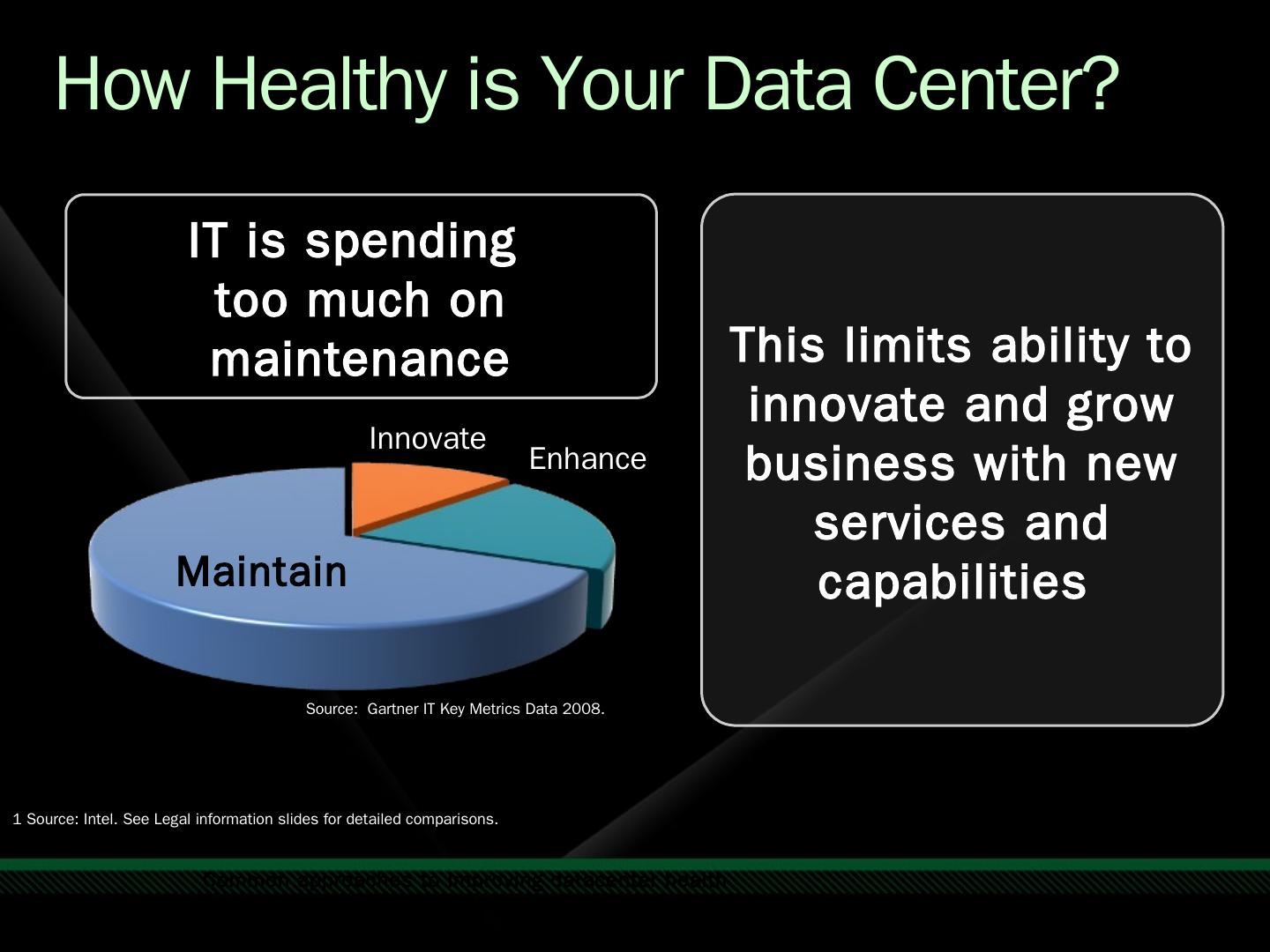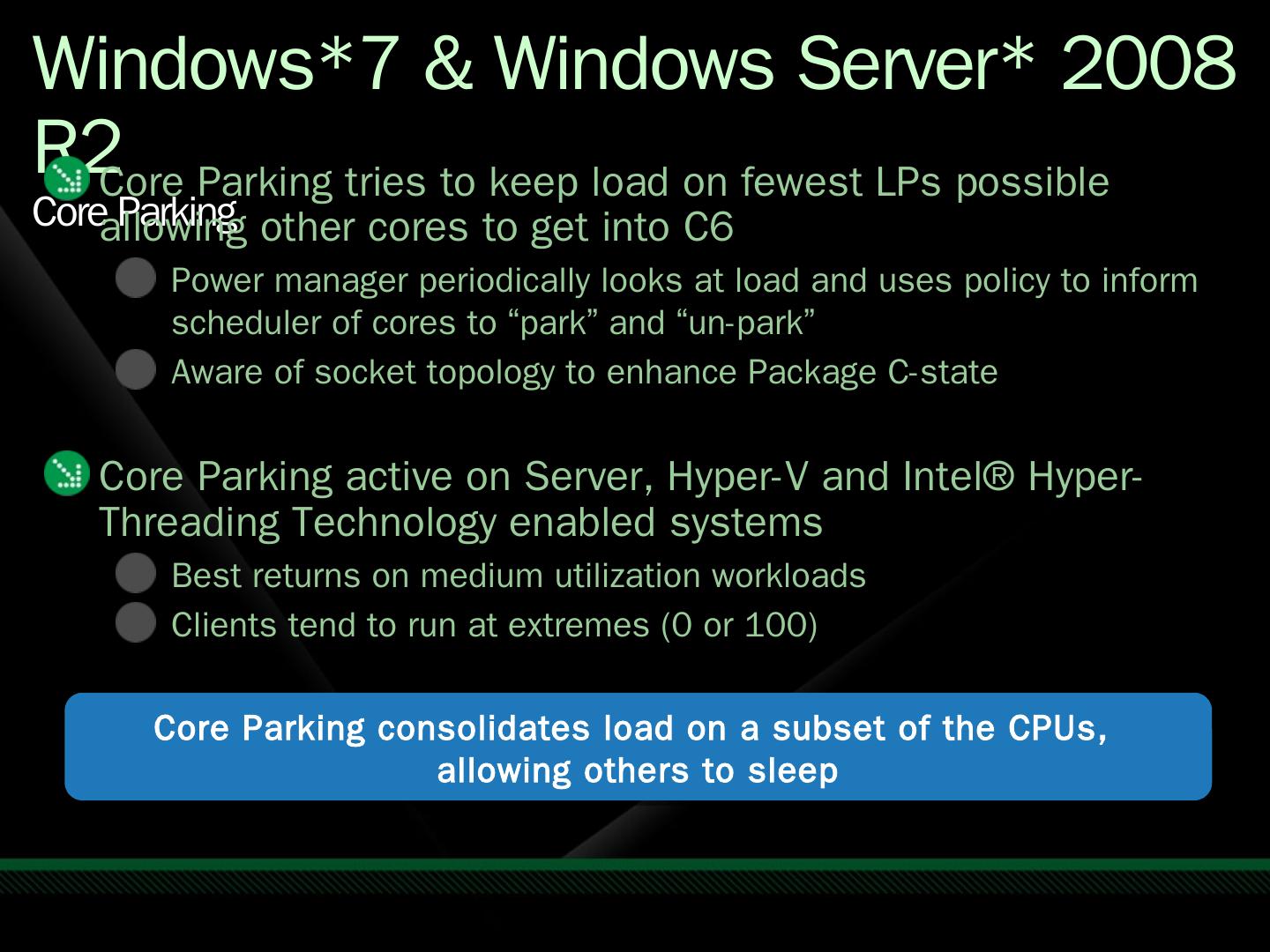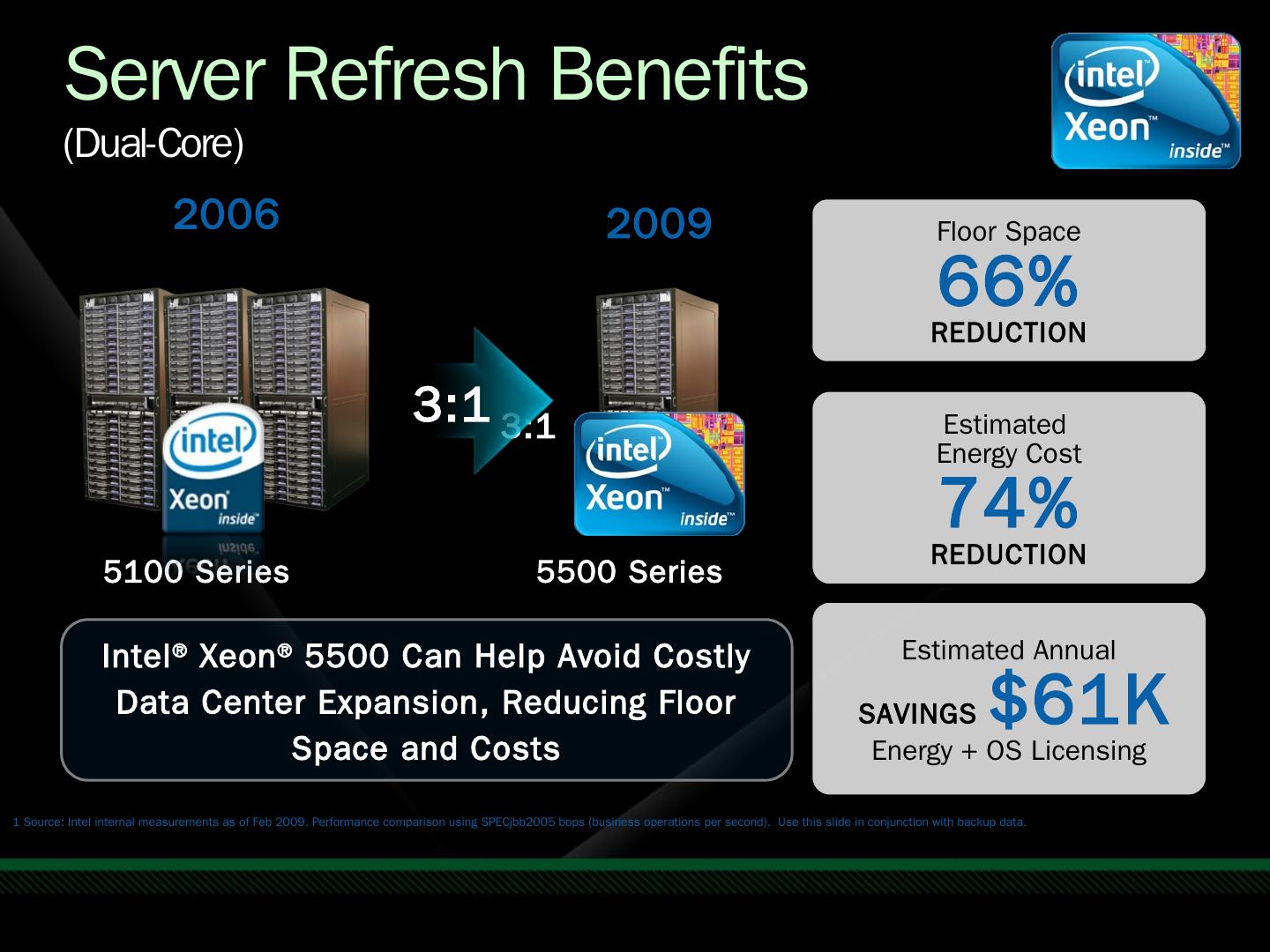- 快召唤伙伴们来围观吧
- 微博 QQ QQ空间 贴吧
- 文档嵌入链接
- <iframe src="https://www.slidestalk.com/u21/intel_turbo_boost_technology_intel_hyper_threading_technology_j1elts?embed" frame border="0" width="640" height="360" scrolling="no" allowfullscreen="true">复制
- 微信扫一扫分享
Intel ® Turbo Boost Technology Intel ® Hyper-Threading Technology
展开查看详情
1 .
2 .Keith Mayer Lead Learning Consultant Enterprise & Partner Group Microsoft Corporation Datacenter Optimization with … Intel Xeon Processor-based Servers and Windows Server 2008 R2 Session Code: SVR210
3 .Agenda Addressing IT Challenges Intel Server Processor Technology Update Intel | Microsoft Collaboration Proof-Points: Real Intel | Microsoft Results Conclusion / Q&A
4 .The Top of Mind Questions for Business IT decision makers are… Why invest in datacenter optimization and IT refresh now ? And, if I do invest… …where should I invest? …how will I know it’s an investment for the long run? …how will I maximize ROI? Evolve your Data Center strategy: from a collection of servers … to a platform “fabric”
5 .IT Constraints on Growth Power & Cooling For every $1 spent on server HW, 50 cents spent on power/cooling Operating Cost $8 in maintenance for every $1 spent on new infrastructure Space Crunch Datacenter construction costs >$1,000/ sq ft Server Sprawl >30m physical servers currently installed: growing 4X next 10 years Source: IDC.
6 .How Healthy is Your Data Center? Source: Gartner IT Key Metrics Data 2008. 1 Source: Intel. See Legal information slides for detailed comparisons. Common approaches to improving datacenter health Maintain Innovate Enhance This limits ability to innovate and grow business with new services and capabilities IT is spending too much on maintenance
7 ."Investing in new infrastructure routinely, like refreshing older servers, is critical. At Intel IT, we found that continually enhancing our existing infrastructure actually reduces the amount required to maintain and run our environment and therefore is a high priority investment for us.” — Diane Bryant, CIO, Intel Corporation Data Center Refresh Strategy
8 .Delivering the service Managing the fabric Data Center Optimization Dynamic Data Center Infrastructure Reliable | Predictable | Automated Broader than virtualization Infrastructure “fabric” Automated management Application platform Identity, security, and access
9 .Physical Infrastructure Infrastructure Services Lifecycle Management Services Critical Qualities Scalable Reliable Efficient Integrated DNS/DHCP Directory Provisioning Deployment Config Management Hardware Management OS Management Virtualization Management Application Management Update Management Dynamic Data Center Fabric Components File/Print Infrastructure Apps Workload Consolidation Virtualization Clustering
10 .Intel Server Processor Technology Update
11 .Intel’s Server Processor Portfolio Aligned with Dynamic Data Center Optimization 2009 Xeon® 5500 Infrastructure Services & Applications Top Performance / $, Energy Efficiency, & Flexibility 5000 Sequence Westmere-EP Consolidation & Enterprise Apps Scalable Performance, Flexibility, & Advanced RAS for Demanding Applications 7000 Sequence Xeon® 7400 Nehalem-EX 2010 Largest Enterprise Applications Highest Scalability and Most Advanced RAS for Most Demanding Environments 9000 Sequence Itanium® 9100 Tukwila
12 .Intel® Xeon® Processor 5500 Series Performance Refresh 2.5x faster Database queries 1 Virtualization Refresh 2.7x performance improvement 3 Energy Efficiency Refresh 5x Reduction in Idle Power 2 The Right Investment – Right Now A tremendous step forward in technology New processor architecture New platform architecture New memory subsystem New I/O subsystem New options with SSDs
13 .Performance Enhancements Intel Xeon® 5500 Series Processor (Nehalem-EP) Intel ® Turbo Boost Technology Intel ® Hyper-Threading Technology Increases performance by increasing processor frequency and enabling faster speeds when conditions allow Frequency Core 0 Core 1 Core 2 Core 3 All cores operate at rated frequency All cores operate at higher frequency Core 0 Higher performance on demand Fewer cores may operate at even higher frequencies 4C Turbo Normal <4C Turbo Increases performance for threaded applications delivering greater throughput and responsiveness Higher performance for threaded workloads Up to 30% higher† Core 1 Core 2 Core 3 Core 0 Core 1 † Source: Intel internal measurements, January 2009. For notes and disclaimers, see performance and legal information slides at end of this presentation.
14 .Energy Efficiency Enhancements Intel ® Intelligent Power Technologies Integrated Power Gates Automated Low Power States Enables idle cores to go to near zero power independently More & Lower CPU Power States Reduced latency during transitions Power management now on memory, I/O Core0 Core1 Core2 Core3 Memory System, Cache, I/O Voltage (cores) Voltage (rest of processor) Automatic or manual core control Adjusts system power consumption based on real-time load new new Enhanced
15 .Nehalem-EX Overview Core4 Core5 Core6 Core7 Core3 Core2 Core1 System Interface Core0 QPI0 QPI1 QPI2 QPI3 SMI SMI Up to 8 Cores/16 Threads 24MB of Shared Cache Integrated Memory Controllers 4 High-bandwidth QPI Links Intel® Hyper-Threading Intel® Turbo Boost 2.3B Transistors The Next Generation Intelligent Expandable Platform
16 .Nehalem-EX: Leadership 4-socket Platform Unmatched Enterprise, Virtualization, and HPC Solutions 32 Cores / 64 Threads Intel® Scalable Memory Interconnect with Buffers 2X Memory Capacity 16 DIMMs per Socket 64 DIMMs per platform Advanced Virtualization & I/O Technologies
17 .Nehalem-EX: 8 Sockets and Above > 15 designs from 8 OEMs Intel Architecture capable of QPI connected 8-Sockets / 128 threads Scalable systems and >8-socket capability with OEM node controllers Scalable performance through modularity Leadership RAS with MCA recovery Targeting High-End Enterprise Apps and Large Scale Consolidation
18 .Nehalem-EX vs. Xeon® 7400 Next Generation MP Advances Memory ~2X RAS CPU & System Sockets 2X Threads / Cache 2.7X / 1.5X Extending Leadership Solutions Consolidation High Data Demands Virtualization Scalability Business Driver Feature
19 .Nehalem-based Server Performance The Greatest Intel® Xeon® Performance Leap In History! Expecting larger gains from Nehalem Architecture in MP Nehalem-EX vs. Xeon ® 7400 Up to 9x Memory Bandwidth 2 > 2.5x Database Performance 1 > 1.7x Integer Throughput > 2.2x Floating Point Throughput 1 Based on May‘09 internal measurement using OLTP workload. 2 Based on May’09 internal measurement using Intel internal workload Xeon ® 5500 vs. Xeon ® 5400 Up to 3.5x Memory Bandwidth Up to 2.5x Database Performance Up to 1.7x Integer Throughput Up to 2.2x Floating Point Throughput
20 .Advanced RAS - MCA Recovery Contain, Correct, Predict Errors Native & Virtually First Machine Check Recovery in Xeon-based Systems Detects CPU, memory, & I/O errors Works with OS to correct Recovers from otherwise fatal system errors “ Microsoft is excited about…our technology collaboration. Windows Server 2008 R2 will support Intel’s upcoming Nehalem-EX MCA recovery features, giving IT professionals confidence to move to higher levels of consolidation.” - Bill Laing, Corporate VP, Microsoft
21 .Intel | Microsoft Technical Collaboration
22 .Intel & Microsoft Technical Collaboration Helping to optimize solution infrastructure with Windows Server 2008 R2 Energy Efficiency Virtualization Intel® Hyper-Threading Technology & Windows scheduler enhancements coupled with increased scalability to 256 logical processors Performance/Scalability Intel’s Deep Power Down Technology and “Get Idle-Stay Idle” enhancements in Windows Server* 2008 R2 Intel’s Machine Check Architecture enhancements and Error Recovery in Windows Server 2008 R2 Intel Virtualization technology such as Virtual Processor Identifiers (VPIDs) and Extended Page Tables helps to enhance Hyper-V performance RAS
23 .Video Segment: Intel Nehalem and Windows Server 2008 R2 Intel and Microsoft Collaboration
24 .Reducing Idle Power Consumption C0 Cn C1 Exit Latency (us) Idle Power (W) Windows* CPU Power Management Framework built on CPU “idle” states (C-states) and “active” states (P-states) OS initiates C-state entry by Mwait instruction Software and Hardware working together to manage power
25 .Intel® Microarchitecture (Nehalem) Deep Power Down Technology (C6) 0 1 Core Power 0 All cores in C0 Core 2 3 0 1 2 3 MWAIT (C6) On Core 1 & Core 2 0 1 2 3 Core 1 gets interrupt “wake-up”. Returns to C0 Integrated Power Gate enables a per core C6 state and individual cores transition to a ~0W Power State
26 .Intel® Microarchitecture (Nehalem) Package C-state Additional logic outside cores When all cores in C6, package can transition to C6 Latency important for some workloads. CPU tracks “wake-up” frequency, over-rides C-state choice as needed Longer average idle & fewer “wake-ups ” improves C6 Residency . “ Get idle, stay idle” Core Core Core Core
27 .Windows*7 & Windows Server* 2008 R2 Intelligent Timer Tick Distribution Before, primary timer interrupt on logical processor 0 propagated timer interrupt to all other Logical Processors (LPs) On Windows 7, timer system wakes up sleeping logical processors only if needed
28 .Windows*7 & Windows Server* 2008 R2 Timer Coalescing Staying idle requires minimizing timer interrupts Before, periodic timers had independent cycles New timer APIs permit timer coalescing Application or driver specifies tolerable delay Hypervisor also implements timer coalescing for guest timers Timer tick 15.6 ms Periodic Timer Events Windows 7 Vista Timer system aligns periods on natural frequency
29 .Windows*7 & Windows Server* 2008 R2 Core Parking Core Parking tries to keep load on fewest LPs possible allowing other cores to get into C6 Power manager periodically looks at load and uses policy to inform scheduler of cores to “park” and “un-park” Aware of socket topology to enhance Package C-state Core Parking active on Server, Hyper-V and Intel® Hyper-Threading Technology enabled systems Best returns on medium utilization workloads Clients tend to run at extremes (0 or 100) Core Parking consolidates load on a subset of the CPUs, allowing others to sleep





















































